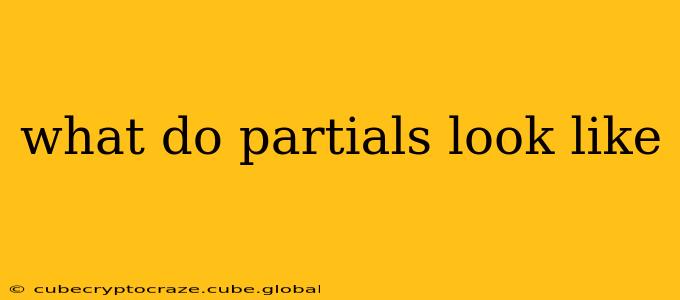What Do Partials Look Like? A Deep Dive into Partial Views
The term "partials" most commonly refers to partial views in the context of web development frameworks like Ruby on Rails, ASP.NET MVC, and others. They are reusable chunks of HTML code that can be included in multiple different views, promoting code reusability, maintainability, and cleaner organization. Think of them as modular components of your website's interface.
But what exactly do they look like? The visual appearance depends entirely on the HTML, CSS, and potentially JavaScript within the partial itself. There's no single "look" to a partial. Instead, it's the functionality and reuse that defines it.
Let's explore different aspects to understand what constitutes a partial and how they're used:
What are the different types of partials?
Partials can encompass various elements, contributing to different parts of your website's layout:
-
Headers and Footers: These are classic examples. A header partial might contain your logo, navigation menu, and search bar. A footer partial could hold copyright information, contact details, and social media links. These are consistent across many pages.
-
Sidebars: If your website utilizes sidebars, they're frequently implemented as partials. This could include navigation, widgets, ads, or other supplemental content.
-
Forms: Login forms, registration forms, comment forms – these are often created as partials for easy reuse throughout the site.
-
Individual Components: Smaller, more specific elements, such as a product card in an e-commerce site, a user profile display, or a comment section, can all be crafted as partials.
How are Partials Structured?
The structure of a partial depends heavily on the framework you are using. However, the general principle remains consistent: it's a self-contained piece of HTML (often with embedded logic) that doesn't represent a complete page on its own.
Here’s a conceptual example of a simple header partial:
<!-- header.html -->
<header>
<h1>My Website</h1>
<nav>
<ul>
<li><a href="/">Home</a></li>
<li><a href="/about">About</a></li>
<li><a href="/contact">Contact</a></li>
</ul>
</nav>
</header>
This header.html file (or whatever your framework's naming convention dictates) contains the HTML for the header. The main page's view would then include this partial using a specific directive provided by the framework (e.g., include, render, or similar).
How do I render/include a Partial?
This process depends on the specific web framework. Each has its own syntax for inserting partials into a main view. You'll need to consult the documentation for your framework (Rails, ASP.NET MVC, etc.) to understand the exact method.
What are the benefits of using Partials?
-
Reusability: The most significant benefit. Change the header in one place, and it updates everywhere it's used.
-
Maintainability: Easier to debug and update smaller, self-contained code units.
-
Organization: Keeps your codebase tidy and more manageable, especially for larger projects.
-
Consistency: Ensures a consistent look and feel across your entire website.
In short, a partial doesn't have a specific visual appearance; its visual output depends entirely on the HTML and styling within the partial file. The key takeaway is its role as a reusable building block in your web application's view layer.
